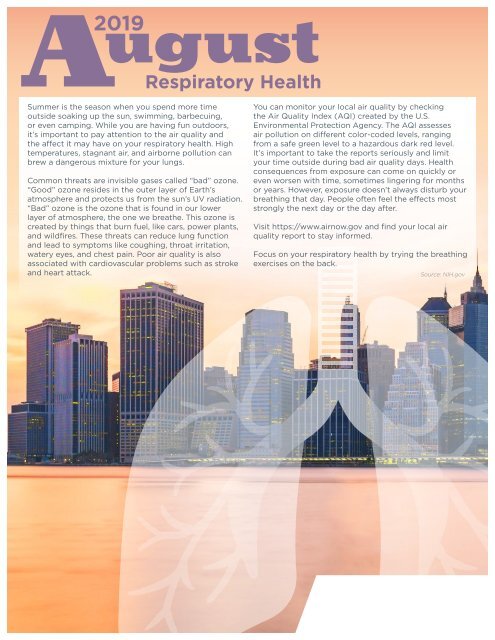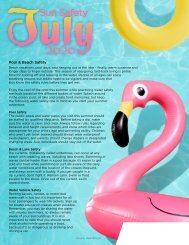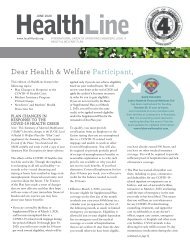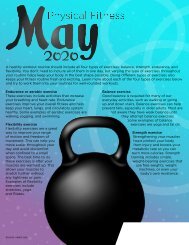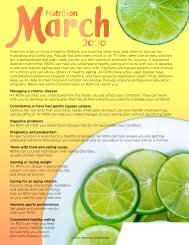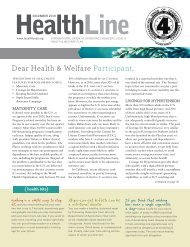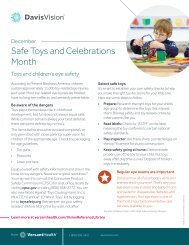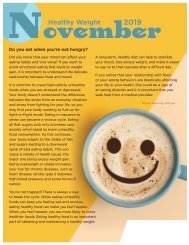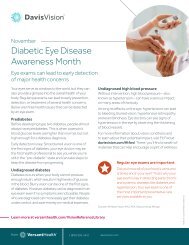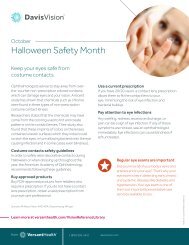BCBS August 2019
You also want an ePaper? Increase the reach of your titles
YUMPU automatically turns print PDFs into web optimized ePapers that Google loves.
Summer is the season when you spend more time<br />
outside soaking up the sun, swimming, barbecuing,<br />
or even camping. While you are having fun outdoors,<br />
it’s important to pay attention to the air quality and<br />
the affect it may have on your respiratory health. High<br />
temperatures, stagnant air, and airborne pollution can<br />
brew a dangerous mixture for your lungs.<br />
Common threats are invisible gases called “bad” ozone.<br />
“Good” ozone resides in the outer layer of Earth’s<br />
atmosphere and protects us from the sun’s UV radiation.<br />
“Bad” ozone is the ozone that is found in our lower<br />
layer of atmosphere, the one we breathe. This ozone is<br />
created by things that burn fuel, like cars, power plants,<br />
and wildfires. These threats can reduce lung function<br />
and lead to symptoms like coughing, throat irritation,<br />
watery eyes, and chest pain. Poor air quality is also<br />
associated with cardiovascular problems such as stroke<br />
and heart attack.<br />
You can monitor your local air quality by checking<br />
the Air Quality Index (AQI) created by the U.S.<br />
Environmental Protection Agency. The AQI assesses<br />
air pollution on different color-coded levels, ranging<br />
from a safe green level to a hazardous dark red level.<br />
It’s important to take the reports seriously and limit<br />
your time outside during bad air quality days. Health<br />
consequences from exposure can come on quickly or<br />
even worsen with time, sometimes lingering for months<br />
or years. However, exposure doesn’t always disturb your<br />
breathing that day. People often feel the effects most<br />
strongly the next day or the day after.<br />
Visit https://www.airnow.gov and find your local air<br />
quality report to stay informed.<br />
Focus on your respiratory health by trying the breathing<br />
exercises on the back.<br />
Source: NIH.gov
Breathing exercises can reduce anxiety<br />
as well as help lessen symptoms from<br />
respiratory conditions such as asthma<br />
and chronic obstructive pulmonary<br />
disease (COPD). Focus on your respiratory<br />
health this month by trying the breathing<br />
exercises below.<br />
Exhaling Slowly<br />
Breathing with a prolonged exhale can help promote relaxation and positive energy.<br />
• Begin by sitting, standing, or lying on your back in a comfortable position.<br />
• Take a comfortable breath in, and let your belly rise or expand as you breathe in for 3 seconds.<br />
• Then breathe out for 7 seconds.<br />
• Repeat at a comfortable rate for 1 minute.<br />
• Stop if you feel lightheaded or short of breath.<br />
Nostril Yoga Breathing<br />
• Alternate nostril yoga breathing exercises<br />
can help decrease blood pressure and<br />
respiration rate.<br />
• Using your right thumb block the right<br />
nostril, to exhale through the left nostril.<br />
• Keeping the right nostril blocked, inhale<br />
through the left nostril.<br />
• Remove your thumb, and use your right<br />
ring finger to block the left nostril, and<br />
exhale through the right nostril.<br />
• Then inhale through the right nostril.<br />
• Remove your ring finger, and use the right<br />
thumb to block the right nostril; exhale,<br />
and repeat.<br />
• The basic pattern should be: inhale, switch,<br />
exhale; inhale, switch, exhale.<br />
• Stop if you feel lightheaded or short<br />
of breath.<br />
Diaphragmatic Breathing<br />
• Diaphragmatic breathing can help promote<br />
sustained attention, mood, and decrease<br />
anxiety.<br />
• Start in a comfortable seated position with<br />
your eyes closed.<br />
• Inhale comfortably, allowing your abdomen<br />
and lower ribcage to expand.<br />
• Then exhale as slowly as you can, allowing<br />
your abdomen to contract.<br />
• Perform this at a slow, comfortable pace<br />
for up to 15 minutes.<br />
• Stop if you feel lightheaded or short<br />
of breath.<br />
Source: medbridgeeducation.com, WebMD.com<br />
Can air filters help your asthma symptoms? Click here to find out.<br />
Allergies can affect your breathing. Watch this video on allergy-proofing your bedroom.<br />
Cleaner air may be tied to healthier lungs in children. Read more here.


